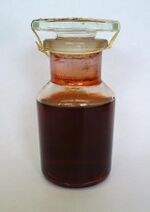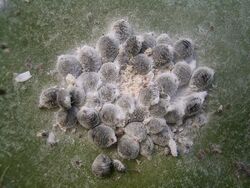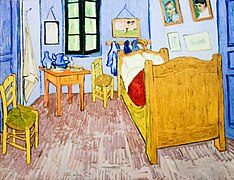Carmine
Topic: Chemistry
 From HandWiki - Reading time: 10 min
From HandWiki - Reading time: 10 min
Etymology
The English word "carmine" is derived from the French word carmin (12th century), from Medieval Latin carminium, from Persian قرمز qirmiz ("crimson"), which itself derives from Middle Persian carmir ("red, crimson").[1] The Persian term carmir is likely cognate with Sanskrit krimiga ("insect-produced"), from krmi ("worm, insect"). The Persian word for "worm, insect" is kirm, and in Iran (Persia) the red colorant carmine was extracted from the bodies of dead female insects such as Kermes vermilio and cochineal.[2]:131 The form of the term may also have been influenced in Latin by minium ("red lead, cinnabar"), said to be of Iberian origin.
The word "carmine" has been used as a color name as early as 1799.[3] It is a popular food color, used in yogurt, candy, gelatin, meat, and beverages including fruit juices.[4][5][6]
History
Female Dactylopius coccus (cochineal) insects were used for their red coloring power as early as 700 BC. South American civilizations crushed the bugs present on cacti to extract the carmine they contain. Carmine pigment was extensively used by the Aztec civilization to dye textiles. It was imported later to Europe during the 16th century.[7](p255)
Red is a color often associated with power and social status. Through the centuries, red has been worn by tribal chiefs, kings and queens, and military officers.[8](p166)
Cochineal was a major source of income for the Spanish Crown. By weight, it was a far more valuable commodity than sugar, making it especially lucrative for overseas trade. As part of the triangular trade, its production and consumption were intertwined with slavery.[8](p64)
In European markets, the Spanish Crown had a monopoly on cochineal until 1820 when the French learned to cultivate them. Later, German and British scientists created a chemical red dye that competed with carmine. The combination of these factors contributed to the end of the Spanish monopoly and considerably lowered the price of carmine, making it accessible to a wider audience.[citation needed]
Production
This section is missing information about synthetic production (claimed to exist in later passage on EU medicine use). (June 2022) |
The pigment is produced from carminic acid, which is extracted from some scale insects such as the cochineal scale (Prima), and certain Porphyrophora species (Armenian cochineal and Polish cochineal). Attempts have been made to farm cochineal.
Carmine is a colorant used in the manufacture of artificial flowers, paints, crimson ink, rouge and other cosmetics, and some medications.[9]
Synthetic carminic acid is complex and expensive to produce. Therefore, natural cochineal carmine is predominant on the market. Its instability presents challenges for use in art and textiles, but this is less of a hindrance in the context of cosmetics.[7](p263)
Preparation
To prepare carmine, the powdered scale insect bodies are boiled in an ammonia or sodium carbonate solution. After separating the insoluble matter, the extract is treated with alum to precipitate the red solid. This precipitate is called "carmine lake" or "crimson lake". Purity of color is ensured by the absence of iron. Stannous chloride, citric acid, borax, or gelatin may be added to modify the precipitation. The traditional crimson color is affected not only by carminic acid but also by choice of its chelating metal salt ion. For shades of purple, lime is added to the alum.[10][11]
To obtain 1 pound of red dye, 70,000 cochineal insects are required.[8](p82)
Zapotec cochineal nests on Opuntia ficus-indica host cacti
Identification and characteristics
Scientists can detect the presence of carminic acid through liquid chromatography and a diode array detector combined with a mass spectrometer with a quadruple-time-of-flight analyzer (LC-DAD-QTOF). The process is used for identifying carmine in works of art.[8](p102)
Scientific methods can also distinguish among the different species of cochineal used in artworks.[citation needed]
Wavelength
As confirmed by reflectance spectroscopy, carmine reflects mostly red light. Its hue ranges from 497 nm for a dark purplish red and 612 nm for a vibrant red.[7](p264)
Hue
Carmine's hue is dependent on the metallic ions present in the pigment. For instance, carmine combined with zinc or aluminum yields a crimson hue.[7](p266)
Translucence
The translucence of carmine depends on its binding medium. Mixed with oil, carmine remains translucent and adequate for glazes. Combined with tempera or glue, carmine turns opaque.[7](p264)
Value
On the Munsell color scale, carmine's value can range between 3.32 and 6.35.[7](p264)
Permanence
Carmine is a fugitive color, whose fading is influenced by different factors such as light, humidity, or even the color of the glass of a frame.[12](pp140-152) It is highly sensitive to light and tends to fade into brownish tones.[12](pp141-144)
In painting, its durability depends on the type of binding. For instance, pigments are more stable if mixed with linseed oil rather than with gum arabic.[13](p1) It is especially sensitive to light in watercolor.[14] Carmine can be stabilized when precipitated with alum and when combined with tin salt mordants.[15](pp698-9)
Notable occurrences in art
Carmine was used in dyeing textiles and in painting since antiquity. Numerous examples are found among Inca remains such as textile artifacts. The Aztecs also used carmine.
In Europe, the 16th century Italian painter Jacopo Tintoretto used carmine in several of his paintings, the most notable being Portrait of Vincenzo Morosini (1575-80) and Christ Washing the Feet of the Disciples(1575-80).[16][17]
Carmine was also used by nineteenth-century artists such as Vincent van Gogh in Bedroom in Arles (1889). The floor of the bedroom is painted with carmine cochineal lake, geranium lake and indigo. This produced a reddish color, which over time changed to blueish.[18]
Analysis of J. M. W. Turner's palettes found that he used cochineal carmine.[19] The fading of this pigment affected the appearance of the sky in The Fighting Temeraire (1839).[20]
Other uses
Architecture
Carmine red has been used in military cartography at least since the 17th century. Sébastien Le Prestre de Vauban, General Engineer of France, recommended the use of this red pigment to represent fortifications (ramparts, wood timbers, and brick buildings being reddish).[21](pp70-71) This made buildings more distinct on maps[22](p104)
Cosmetics
Carmine is present in numerous cosmetics because of its red color. This use has continued from antiquity to the present.[8](p29) It can be found in lipstick, eye shadow, nail polish. It may cause allergies.[23]
Histology
Carmine can be used in histology, as Best's carmine to stain glycogen, mucicarmine to stain acidic mucopolysaccharides, and carmalum to stain cell nuclei. In these applications, it is applied together with a mordant, usually an Al(III) salt.[citation needed]
Medicine
Cochineal, the insect used to make carmine, also has medical properties that were exploited by the Aztecs.[8](p30) It is said to help cure wounds when mixed with vinegar and applied to lesions. Aztecs used it to clean teeth.[citation needed]
Regulations for use in foods

United States
In January 2006, the United States Food and Drug Administration (FDA) evaluated a proposal that would require food products containing carmine to list it by name on the ingredient label.[24] It was also announced that the FDA will separately review the ingredient labels of prescription drugs that contain colorings derived from carmine. A request from the Center for Science in the Public Interest urging the FDA to require ingredient labels to explicitly state that carmine is derived from insects and may cause severe allergic reactions and anaphylactic shock was declined by the FDA.[25][26] Food industries were aggressively opposed to the idea of writing "insect-based" on the label, and the FDA agreed to allow "cochineal extract" or "carmine".[27]
European Union
In the European Union (EU), the use of carmine in foods is regulated under the European Commission's directives governing food additives in general[28][29] and food dyes in particular[30] and listed under the names Cochineal, Carminic acid, Carmines and Natural Red 4 as additive E 120 in the list of EU-approved food additives.[31] The directive governing food dyes approves the use of carmine for certain groups of foods only[32] and specifies a maximum amount which is permitted or restricts it to the quantum satis.[citation needed]
The EU-Directive 2000/13/EC[33] on food labeling mandates that carmines (like all food additives) must be included in the list of ingredients of a food product with its additive category and listed name or additive number, that is either as Food colour carmines or as Food colour E 120 in the local language(s) of the market(s) the product is sold in.[citation needed]
References
- ↑ Mackenzie, D. (1971). A Concise Pahlavi Dictionary. Oxford University Press. pp. 50–51.
- ↑ Purinton, N., & Watters, M. (1991). A Study of the Materials Used by Medieval Persian Painters. Journal of the American Institute for Conservation, 30(2), 125-144.
- ↑ "Online Etymology Dictionary". Etymonline.com. http://www.etymonline.com/index.php?term=carmine.
- ↑ "Carmine Market: Global Size, Demand, Share, Trends, Analysis, Growth and Forecast 2022-2027" (in EN-US). MarketWatch. February 1, 2022. https://www.marketwatch.com/press-release/carmine-market-global-size-demand-share-trends-analysis-growth-and-forecast-2022-2027-2022-02-01.
- ↑ Miller, Brittney J. (25 March 2022). "Cochineal, a red dye from bugs, moves to the lab". Knowable Magazine. doi:10.1146/knowable-032522-1. https://knowablemagazine.org/article/technology/2022/cochineal-red-dye-bugs-moves-lab. Retrieved 28 March 2022.
- ↑ Pearson, Gwen (September 10, 2015). "You Know What Makes Great Food Coloring? Bugs". Wired. https://www.wired.com/2015/09/cochineal-bug-feature/. Retrieved 29 March 2022.
- ↑ 7.0 7.1 7.2 7.3 7.4 7.5 Schweppe, Helmut; Roosen-Runge, Heinz (1986). "Carmine". in Feller, Robert L. (in English). Artists’ Pigment: A History of Their History and Characteristics. 1. Washington: National Gallery of Art.
- ↑ 8.0 8.1 8.2 8.3 8.4 8.5 Padilla, Carmella, ed (2015). A red like no other : how cochineal colored the world : an epic story of art, culture, science, and trade. New York, NY: Skira/Rizzoli.
- ↑ Hunger, Klaus; Herbst, Willy (2000). "Ullmann's Encyclopedia of Industrial Chemistry". Ullmann's Encyclopedia of Industrial Chemistry. Weinheim: Wiley-VCH. doi:10.1002/14356007.a20_371.
- ↑ "Important Dates in Fabric History". Time Line of Fabric Information. Threads In Tyme. http://threadsintyme.tripod.com/id63.htm.
- ↑ "E-numbers: E120: Carmine, Carminic acid, Cochineal". Food-Info.net. http://www.food-info.net/uk/e/e120.htm.
- ↑ 12.0 12.1 Brommelle, N. S. (1964). "The Russell and Abney Report on the Action of Light on Water Colours". Studies in Conservation 9 (4). doi:10.2307/1505213. ISSN 0039-3630. https://www.jstor.org/stable/1505213.
- ↑ Miyamoto, Bénédicte (2019). "Significant Red: Watercolour and the Uses of Red Pigments in Military and Architectural Conventions" (in en). XVII-XVIII Revue de la Société d'études anglo-américaines des XVIIe et XVIIIe siècles 75. https://shs.hal.science/halshs-01970069.
- ↑ "Pigments through the Ages - Technical Information - Carmine lake". https://www.webexhibits.org/pigments/indiv/technical/carmine.html.
- ↑ Merrifield, Mary P (1849). Original Treatises, Dating from the xiith to the xviith Centuries, [o]n the Arts of Painting. New York: Dover, 1967.
- ↑ "Tintoretto, Portrait of Vincenzo Morosini" (in en-US). https://colourlex.com/project/tintoretto-portrait-of-vincenzo-morosini/.
- ↑ "Tintoretto, Christ Washing the Feet of the Disciples" (in en-US). https://colourlex.com/project/tintoretto-christ-washing-the-feet-of-the-disciples/.
- ↑ "Van Gogh, Bedrom in Arles" (in en-US). https://colourlex.com/project/van-gogh-bedroom-in-arles/.
- ↑ Townsend, Joyce H. (1993). "The Materials of J. M. W. Turner: Pigments". Studies in Conservation 38 (4): 231–254. doi:10.2307/1506368. ISSN 0039-3630. https://www.jstor.org/stable/1506368.
- ↑ "Palettes of the masters: JMW Turner" (in en-GB). https://www.winsornewton.com/row/articles/art-history/palettes-masters-jmw-turner/.
- ↑ Vauban, Sebastien Le Prestre (1685). Directeur général des fortifications, par Monsieur de Vauban, Ingénieur Général de France.. La Haye: Van Bulderen.
- ↑ Gautier, Hubert (1687). L’art de laver: ou la nouvelle manière de peindre sur le papier: suivant le coloris des desseins qu’on envoye a la cour.. Lyon: Thomas Amaulry.
- ↑ Sadowska, Beata; Sztormowska, Marlena; Gawinowska, Marika; Chełmińska, Marta (2022). "Carmine allergy in urticaria patients". Advances in Dermatology and Allergology 39 (1): 94–100. doi:10.5114/ada.2020.100821. ISSN 1642-395X. PMID 35369613. PMC 8953891. https://www.termedia.pl/doi/10.5114/ada.2020.100821.
- ↑ Docket No. 1998P–0724, formerly 98P–0724; RIN 0910–AF12. Listing of Color Additives Exempt From Certification; Food, Drug, and Cosmetic Labeling: Cochineal Extract and Carmine Declaration.
- ↑ "FDA Urged Improve Labeling of or Ban Carmine Food Coloring". Cspinet.org. 1998-08-24. http://www.cspinet.org/new/carmine_8_24_98.htm.
- ↑ "Bug-Based Food Dye Should Be ... Exterminated, Says CSPI". Cspinet.org. 2006-05-01. http://www.cspinet.org/new/200605011.html.
- ↑ "Summary of Color Additives for Use in the United States in Foods, Drugs, Cosmetics, and Medical Devices". US Food & Drug Administration. November 2017. https://www.fda.gov/industry/color-additive-inventories/summary-color-additives-use-united-states-foods-drugs-cosmetics-and-medical-devices.
- ↑ "Food Additives in Europe". Foodlaw.rdg.ac.uk. http://www.foodlaw.rdg.ac.uk/additive.htm.
- ↑ "Archived copy". http://www.fsai.ie/legislation/food/eu_docs/Food_additives/General_provisions/Dir%20292.97%20EC.pdf.
- ↑ "European Parliament and Council Directive 94/36/EC of 30 June 1994 on colours for use in foodstuffs". Food Safety authority of Ireland. http://www.fsai.ie/uploadedFiles/European_Parliament_and_Council_Directive_94_36_EC.pdf.
- ↑ "Food Standards Agency - Current EU approved additives and their E Numbers". Food.gov.uk. 2012-03-14. http://www.food.gov.uk/safereating/chemsafe/additivesbranch/enumberlist.
- ↑ a list of approved uses is included in Annexes I and III of EU-Directive 94/36 [1]
- ↑ "Archived copy". http://www.fsai.ie/legislation/food/eu_docs/Labelling/General%20Labelling%20Provisions%20for%20Foodstuffs/Dir%202000.13%20EC.pdf.
- Attribution
See also
- Red pigments
Further reading
- Dutton, LaVerne M. Cochineal: A Bright Red Animal Dye (Master's degree). Baylor University. Retrieved November 13, 2010.
- Greenfield, Amy Butler (2005). A Perfect Red: Empire, Espionage, and the Quest for the Color of Desire. New York: HarperCollins. ISBN 978-0-06-052275-9. https://archive.org/details/perfectred00amyb_0.
External links
- Carmine as pigment in painting, at ColourLex
 |
 KSF
KSF










